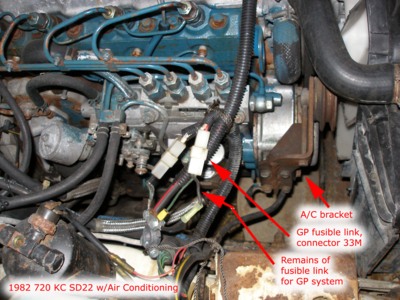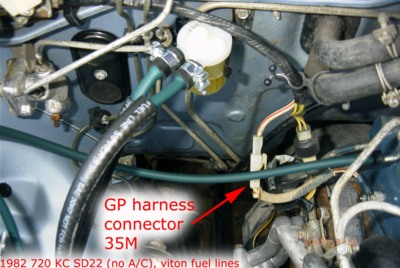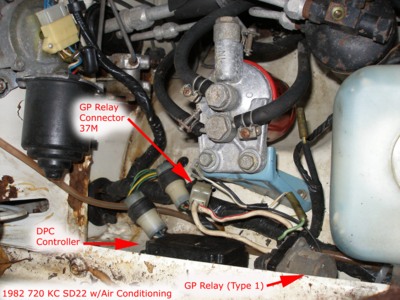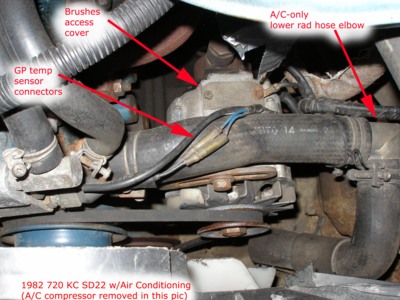* Cold Weather Starting Difficulty *
Moderators: plenzen, Nissan_Ranger
-
EvergreenSD
- Posts: 70
- Joined: 19 years ago
- Location: Eugene, OR
I'm due to take my injectors in to be rebuilt this week and I'm definitely hoping for an outcome like Moose60's. My cold-start smoke and missing is really starting to be a drag.
My question is what is the best way to remove the injectors? I'm trying to determine if there are any tools I will need to purchase before I tackle this. Taking the injector lines off is no problem. Then I assume that I loosen the next nut down to remove the lines that go between the injectors. This leaves two more hex-shaped parts. Can these be removed together or do I have to remove them one at a time? Do I need to find a 27mm deep socket for this or is there another way? How difficult should I expect them to be to loosen? Thanks for the advice.
My question is what is the best way to remove the injectors? I'm trying to determine if there are any tools I will need to purchase before I tackle this. Taking the injector lines off is no problem. Then I assume that I loosen the next nut down to remove the lines that go between the injectors. This leaves two more hex-shaped parts. Can these be removed together or do I have to remove them one at a time? Do I need to find a 27mm deep socket for this or is there another way? How difficult should I expect them to be to loosen? Thanks for the advice.
'82 SD22 720 Kingcab with flatbed
- asavage
- Site Admin
- Posts: 5459
- Joined: 20 years ago
- Location: Oak Harbor, Wash.
- Has thanked: 5 times
- Been thanked: 4 times
- Contact:
Injectors post. Yes, 27mm deep socket (according to Philip).EvergreenSD wrote: My question is what is the best way to remove the injectors? . . . This leaves two more hex-shaped parts. Can these be removed together or do I have to remove them one at a time? Do I need to find a 27mm deep socket for this or is there another way?
Regards,
Al S.
1982 Maxima diesel wagon, 2nd & 4th owner, 165k miles, rusty & burgundy/grey. Purchased 1996, SOLD 16Feb10
1983 Maxima diesel wagon, 199k miles, rusty, light yellow/light brown. SOLD 14Jul07
1981 720 SD22 (scrapped 04Sep07)
1983 Sentra CD17, 255k, bought 06Jul08, gave it away 22Jun10.
Al S.
1982 Maxima diesel wagon, 2nd & 4th owner, 165k miles, rusty & burgundy/grey. Purchased 1996, SOLD 16Feb10
1983 Maxima diesel wagon, 199k miles, rusty, light yellow/light brown. SOLD 14Jul07
1981 720 SD22 (scrapped 04Sep07)
1983 Sentra CD17, 255k, bought 06Jul08, gave it away 22Jun10.
-
moose60
- Posts: 168
- Joined: 19 years ago
- Location: Seattle WA
So, there is something that I have not made explicitly clear... To be brief, my injector rebuild did not cure my cold start problems. It seemed like it did, but those were warmer months, and I was eager to see the results I wanted.
I have found that if fire up the truck and let it idle as slow as possible, the afterglow system will stay on longer (like is's supposed to do) and I get a pretty clean start down to about 55 def F.
I think that I have a bad afterglow timer unit (near the glovebox), and an old diaghpram which stiffens in the cold.
I just don't want to get your hopes up too high.
Byron
I have found that if fire up the truck and let it idle as slow as possible, the afterglow system will stay on longer (like is's supposed to do) and I get a pretty clean start down to about 55 def F.
I think that I have a bad afterglow timer unit (near the glovebox), and an old diaghpram which stiffens in the cold.
I just don't want to get your hopes up too high.
Byron
Byron
82 Datsun 720 KC SD22
MPG Machine
82 Datsun 720 KC SD22
MPG Machine
-
moose60
- Posts: 168
- Joined: 19 years ago
- Location: Seattle WA
27mm deep socket
I believe that a 27mm, is ls close enough to 1-1/16 inch. This size may be easier to find. I would say to go easy when removing the overflow lines. If they bend too much...
Byron
Byron
Byron
82 Datsun 720 KC SD22
MPG Machine
82 Datsun 720 KC SD22
MPG Machine
- philip
- Deceased
- Posts: 1494
- Joined: 20 years ago
- Location: Southern California, USA
The AutoAfterGlow Timer does register a "running" signal from the alternator. From this signal, the glow plugs on the SD22 are kept ON for the first 30 seconds of engine running. RPM is not measured rather, alternator output is registered.moose60 wrote:I have found that if fire up the truck and let it idle as slow as possible, the afterglow system will stay on longer (like is's supposed to do) and I get a pretty clean start down to about 55 def F.
I think that I have a bad afterglow timer unit (near the glovebox), and an old diaghpram which stiffens in the cold.
I just don't want to get your hopes up too high.
Byron
Now IF in fact you find (with a stopwatch) that engine RPM affects the length of "after glow" time, then I would suspect faulty connections at the coolant sensor wires. These carry a very LOW current and the two bullet connections are pretty vulnerable. An open circuit brought about by engine vibration would make the AutoAfterGlow timer maximize glow times.
-Philip
Passed 08May2008
My friend, you are missed . . .
1982 Datsun 720KC SD-22
"Im slow and I'm ahead of you"
Passed 08May2008
My friend, you are missed . . .
1982 Datsun 720KC SD-22
"Im slow and I'm ahead of you"
-
EvergreenSD
- Posts: 70
- Joined: 19 years ago
- Location: Eugene, OR
I'm being thick lately (too many other things going on) and missed a couple posts that would have been very helpful before I pulled the injectors yesterday afternoon. I wasn't able to find a 27mm deep socket and the one I bought wouldn't reach. I used a 22mm socket to remove the fuel bleed lines (they sure are fragile) and then a 24mm box end to pull the injectors.
So Moose, before you said that your injector rebuild cured 95% of your cold start issues. Now that it's been colder what percentage improvement would you say you're down to now? I really want to solve this issue but cash is very tight as well. It sounds like I really need to push to have the injectors bench tested before I shell out for the rebuild. What do you guys think?
So Moose, before you said that your injector rebuild cured 95% of your cold start issues. Now that it's been colder what percentage improvement would you say you're down to now? I really want to solve this issue but cash is very tight as well. It sounds like I really need to push to have the injectors bench tested before I shell out for the rebuild. What do you guys think?
'82 SD22 720 Kingcab with flatbed
- asavage
- Site Admin
- Posts: 5459
- Joined: 20 years ago
- Location: Oak Harbor, Wash.
- Has thanked: 5 times
- Been thanked: 4 times
- Contact:
Keep in mind that we are talking about a truck that is well over 20 years old. Things are going to be reaching the end of their service life constantly. If you are going to use it for a daily driver, you will have to pony up the bucks to maintain it -- or use it up, drive it into the ground. There isn't any alternative. Old equipment demands more time & money to maintain than new equipment, and is less reliable (playing the averages).
On these older diesels, injector replacement is like a consumable -- they wear out, like brakes. You're trying to determine how much brake friction material you have left. If you have any doubt at all, just replace the injectors. Budget about $250 for them.
On these older diesels, injector replacement is like a consumable -- they wear out, like brakes. You're trying to determine how much brake friction material you have left. If you have any doubt at all, just replace the injectors. Budget about $250 for them.
Regards,
Al S.
1982 Maxima diesel wagon, 2nd & 4th owner, 165k miles, rusty & burgundy/grey. Purchased 1996, SOLD 16Feb10
1983 Maxima diesel wagon, 199k miles, rusty, light yellow/light brown. SOLD 14Jul07
1981 720 SD22 (scrapped 04Sep07)
1983 Sentra CD17, 255k, bought 06Jul08, gave it away 22Jun10.
Al S.
1982 Maxima diesel wagon, 2nd & 4th owner, 165k miles, rusty & burgundy/grey. Purchased 1996, SOLD 16Feb10
1983 Maxima diesel wagon, 199k miles, rusty, light yellow/light brown. SOLD 14Jul07
1981 720 SD22 (scrapped 04Sep07)
1983 Sentra CD17, 255k, bought 06Jul08, gave it away 22Jun10.
- philip
- Deceased
- Posts: 1494
- Joined: 20 years ago
- Location: Southern California, USA
See: Fuel injector removalEvergreenSD wrote: I wasn't able to find a 27mm deep socket and the one I bought wouldn't reach. I used a 22mm socket to remove the fuel bleed lines (they sure are fragile) and then a 24mm box end to pull the injectors.
It is necessary to remove the ENTIRE injector for nozzel housing servicing. For this you need a deep 27mm (1-1/16") socket. There is more to this job than just replacing parts.
-Philip
Passed 08May2008
My friend, you are missed . . .
1982 Datsun 720KC SD-22
"Im slow and I'm ahead of you"
Passed 08May2008
My friend, you are missed . . .
1982 Datsun 720KC SD-22
"Im slow and I'm ahead of you"
-
EvergreenSD
- Posts: 70
- Joined: 19 years ago
- Location: Eugene, OR
-
EvergreenSD
- Posts: 70
- Joined: 19 years ago
- Location: Eugene, OR
Now I'm really starting to question the feeling that I've had that an injector rebuild would cure my woes. Perhaps the problem really is cylinder heat-related ( as has already been wisely suggested).
Let me first summarize the reasons that I felt confident that my glow system is working properly. First, the engine starts promptly, with little cranking, even in cold weather. Also, the GP's clearly make a difference, the times I have forgotten to warm them (say a cold restart) the engine does not start. Lastly, the system 'behaves' like I understand it should. The time the GP light stays on varies according to engine temperature. The system stays on well after that before it clunks off. The afterglow also seems to be working as I can hear it clunk off maybe 20 seconds after the engine starts.
So here's my new theory. What if the system is working properly except that one GP is either not working or is working poorly? This cylinder would miss and smoke on startup and also take a long time to warm up and fire properly since combustion is not taking place. This miss would endure until enough heat transmits through the head to allow proper combustion. Does this seem credible?
I have new glow plugs and the problem was the same before I replaced them. So it seems as though I might have a problem with the wire feeding one of the plugs (the last one on the chain?).
Question, given that I have the injectors out already, if I cycled the glowplugs would I be able to see them glow (or the lack thereof) by looking down the injector hole? Could I feel warmth? This would give me an assesment of how the system is working presently.
I look forward to your comments, criticisms, or whatever else you might be able to offer. Thank you for all the guidance.
Let me first summarize the reasons that I felt confident that my glow system is working properly. First, the engine starts promptly, with little cranking, even in cold weather. Also, the GP's clearly make a difference, the times I have forgotten to warm them (say a cold restart) the engine does not start. Lastly, the system 'behaves' like I understand it should. The time the GP light stays on varies according to engine temperature. The system stays on well after that before it clunks off. The afterglow also seems to be working as I can hear it clunk off maybe 20 seconds after the engine starts.
So here's my new theory. What if the system is working properly except that one GP is either not working or is working poorly? This cylinder would miss and smoke on startup and also take a long time to warm up and fire properly since combustion is not taking place. This miss would endure until enough heat transmits through the head to allow proper combustion. Does this seem credible?
I have new glow plugs and the problem was the same before I replaced them. So it seems as though I might have a problem with the wire feeding one of the plugs (the last one on the chain?).
Question, given that I have the injectors out already, if I cycled the glowplugs would I be able to see them glow (or the lack thereof) by looking down the injector hole? Could I feel warmth? This would give me an assesment of how the system is working presently.
I look forward to your comments, criticisms, or whatever else you might be able to offer. Thank you for all the guidance.
'82 SD22 720 Kingcab with flatbed
- philip
- Deceased
- Posts: 1494
- Joined: 20 years ago
- Location: Southern California, USA
I used to witness this very fact in temperatures near freezing until I discovered the one glow with heater element sheath damage. I've attempted a cold start up with the glow plug wire disconnected when the truck had sat all day in 80 degree heat. No start! These engines are VERY dependent on those glow plugs all working.EvergreenSD wrote: So here's my new theory. What if the system is working properly except that one GP is either not working or is working poorly? This cylinder would miss and smoke on startup and also take a long time to warm up and fire properly since combustion is not taking place. This miss would endure until enough heat transmits through the head to allow proper combustion. Does this seem credible?
Not likely though worth checking. I did fabricate a new harnass for my engine. Can't say it made any difference beyond making my "feel bad" feel good again. For start ups, heat is generated from RAPID air compression and from glow plugs. I'm suggesting that good glow plug heat won't make up for low compression or slow starter RPM.EverGreenSD wrote: So it seems as though I might have a problem with the wire feeding one of the plugs (the last one on the chain?).
EverGreenSD wrote: Question, given that I have the injectors out already, if I cycled the glowplugs would I be able to see them glow (or the lack thereof) by looking down the injector hole?
View of Glow Plug operation with Injector Removed
-Philip
Passed 08May2008
My friend, you are missed . . .
1982 Datsun 720KC SD-22
"Im slow and I'm ahead of you"
Passed 08May2008
My friend, you are missed . . .
1982 Datsun 720KC SD-22
"Im slow and I'm ahead of you"
- asavage
- Site Admin
- Posts: 5459
- Joined: 20 years ago
- Location: Oak Harbor, Wash.
- Has thanked: 5 times
- Been thanked: 4 times
- Contact:
Good clarification!EvergreenSD wrote:Just to clarify, when I turned the 24mm nut, the entire injector loosened and came out.
I can't answer your Q about observing the GPs with the injectors removed, but I can say that the GP wiring connectors and fusible link are trouble areas. From your description, it seems certain that the GPs are getting some current, but unless you put a voltmeter on the No. 1 GP and measure delivered voltage with the GP load on and the GP system operating, you can't know if the intermediate parts are working well.
Quick check: Check battery voltage at the battery with GP system energized. Is it greater than 11v? If so, connect voltmeter negative lead to No. 1 GP terminal, and positive lead to battery positive, energize GP system. This measures the voltage drop across all the GP system's load connectors and the relay. Ideally, you'd like 0.1v measured at the voltmeter; real-world, I'd probably be OK with anything up to a half-volt. If you're measuring two or three volts, you've found your problem (in a general sense): you are "dropping" voltage under load. In order of likelihood (and bearing in mind that I haven't had to fool with an SD GP system in about a year):
- GP fusible link (connector 33M on this diagram), right off the positive battery terminal (click on image for larger):

The spade terminals do not hold up for 20 years very well. Remove the terminals and use crimp butt connectors and a quality crimping tool to re-establish a good connection. Very common problem. In the picture above, only one of the two spade terminals has been bypassed -- the one shown is still in decent shape; the one on the battery terminal was, er, terminal. - GP wire off the back of the engine (connector 35M on this diagram), where it leads to the GP relay (click on image for larger):

Same kind of 5/16" spade terminal as the fusible link, these hold up a bit better IMO but are still a trouble spot. Wire is White/Red. - GP relay connector (connector 37M on this diagram) (click on image for larger):
 .
. - GP Relay. I haven't had one fail, but it switches a heavy load for a long time. You can test it by putting the voltmeter's leads across its terminals and energizing the GP system, same test as before. Under 0.2v max! If using an analog voltmeter, figure out which lead is "hot" and put the voltmeter's positive lead on that terminal. If using a DVM, polarity doesn't matter.
Last edited by asavage 19 years ago, edited 5 times in total.
Regards,
Al S.
1982 Maxima diesel wagon, 2nd & 4th owner, 165k miles, rusty & burgundy/grey. Purchased 1996, SOLD 16Feb10
1983 Maxima diesel wagon, 199k miles, rusty, light yellow/light brown. SOLD 14Jul07
1981 720 SD22 (scrapped 04Sep07)
1983 Sentra CD17, 255k, bought 06Jul08, gave it away 22Jun10.
Al S.
1982 Maxima diesel wagon, 2nd & 4th owner, 165k miles, rusty & burgundy/grey. Purchased 1996, SOLD 16Feb10
1983 Maxima diesel wagon, 199k miles, rusty, light yellow/light brown. SOLD 14Jul07
1981 720 SD22 (scrapped 04Sep07)
1983 Sentra CD17, 255k, bought 06Jul08, gave it away 22Jun10.
- asavage
- Site Admin
- Posts: 5459
- Joined: 20 years ago
- Location: Oak Harbor, Wash.
- Has thanked: 5 times
- Been thanked: 4 times
- Contact:
I just happened to find a pic of this, recently taken of my old "Bellingham" truck (click on image for larger):philip wrote:Now IF in fact you find (with a stopwatch) that engine RPM affects the length of "after glow" time, then I would suspect faulty connections at the coolant sensor wires. These carry a very LOW current and the two bullet connections are pretty vulnerable.

Regards,
Al S.
1982 Maxima diesel wagon, 2nd & 4th owner, 165k miles, rusty & burgundy/grey. Purchased 1996, SOLD 16Feb10
1983 Maxima diesel wagon, 199k miles, rusty, light yellow/light brown. SOLD 14Jul07
1981 720 SD22 (scrapped 04Sep07)
1983 Sentra CD17, 255k, bought 06Jul08, gave it away 22Jun10.
Al S.
1982 Maxima diesel wagon, 2nd & 4th owner, 165k miles, rusty & burgundy/grey. Purchased 1996, SOLD 16Feb10
1983 Maxima diesel wagon, 199k miles, rusty, light yellow/light brown. SOLD 14Jul07
1981 720 SD22 (scrapped 04Sep07)
1983 Sentra CD17, 255k, bought 06Jul08, gave it away 22Jun10.
-
EvergreenSD
- Posts: 70
- Joined: 19 years ago
- Location: Eugene, OR
Well it was a nice theory while it lasted. I went home yesterday and cycled the GP's on and watched all 4 of them glow bright red.
I'm working on a new theory involving the lift pump. I recently noticed that the priming pump leaks when I pump it. Could this be related to my problem? The pump does not leak the rest of the time but is it possible that it is drawing in air through a rip in the diaphram or something of the like? Maybe this would explain why the truck had an electric fuel pump by the tank when I got it, though the wires had been cut.
Seeing this also brought to mind a couple anomalous starting issues it has had in the last six months. One time when it had been sitting for several days without being driven it stalled several times even though the temperatures were in the 70's. Another time, most untypically, it just wouldn't start until I operated the priming pump a few times. Could these be signs of lift pump failure?
I'm working on a new theory involving the lift pump. I recently noticed that the priming pump leaks when I pump it. Could this be related to my problem? The pump does not leak the rest of the time but is it possible that it is drawing in air through a rip in the diaphram or something of the like? Maybe this would explain why the truck had an electric fuel pump by the tank when I got it, though the wires had been cut.
Seeing this also brought to mind a couple anomalous starting issues it has had in the last six months. One time when it had been sitting for several days without being driven it stalled several times even though the temperatures were in the 70's. Another time, most untypically, it just wouldn't start until I operated the priming pump a few times. Could these be signs of lift pump failure?
'82 SD22 720 Kingcab with flatbed
-
moose60
- Posts: 168
- Joined: 19 years ago
- Location: Seattle WA
This is exactly what I have found.philip wrote:
Now IF in fact you find (with a stopwatch) that engine RPM affects the length of "after glow" time
My understanding of the issue is (I think) simmilar. If these connections are interupted (broken, disconected, coroded), the afterglow timer will "see" infinite resistance and maximize glow times. On my truck, even with the connection to the coolant temp sensor broken, I can still cause the afterglow to stop by revving the engine.philip wrote: , then I would suspect faulty connections at the coolant sensor wires. These carry a very LOW current and the two bullet connections are pretty vulnerable. An open circuit brought about by engine vibration would make the AutoAfterGlow timer maximize glow times.
I want the correct amount of afterglow. If I rev the engine too high on a cold start, the afterglow kicks off (I can hear the 'thunk'), and the truck begins to mis-fire and smoke, until things warm up a bit more. However, if I keep the revs low, I do not hear the 'thunk' for 20-30 sec, and things go much less smokily.
Byron
Byron
82 Datsun 720 KC SD22
MPG Machine
82 Datsun 720 KC SD22
MPG Machine
Who is online
Users browsing this forum: Bing [Bot] and 12 guests